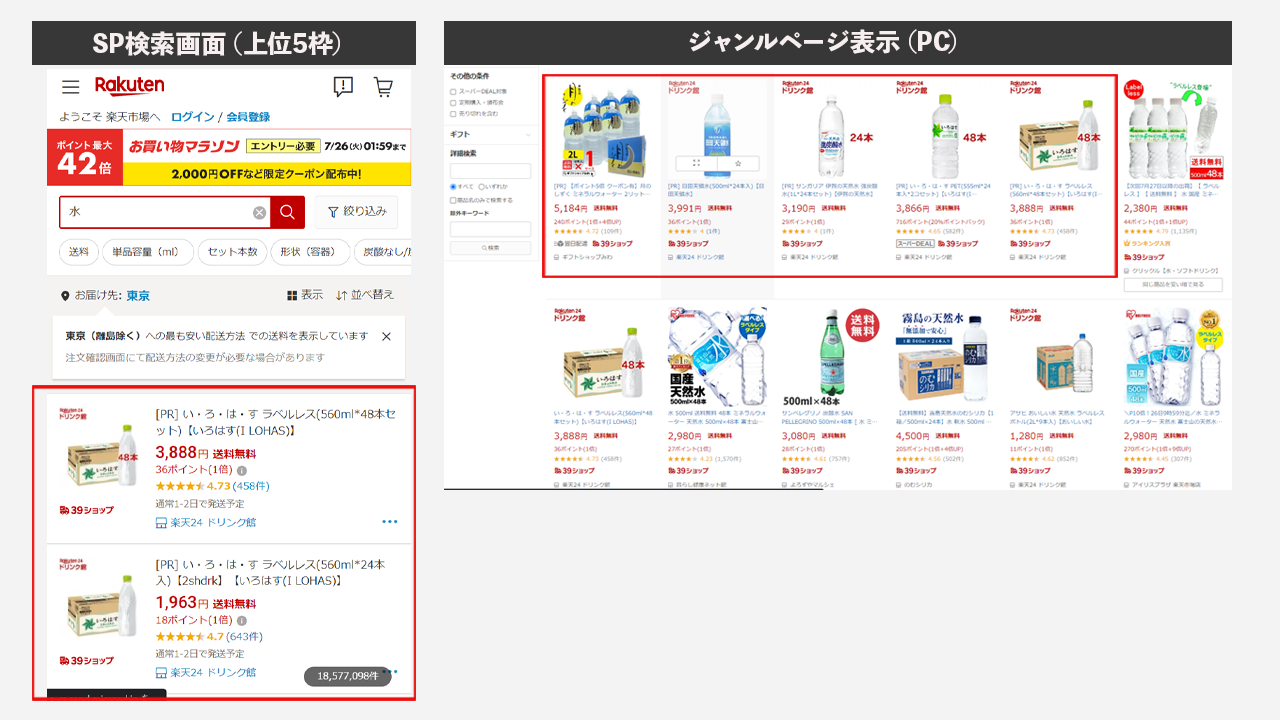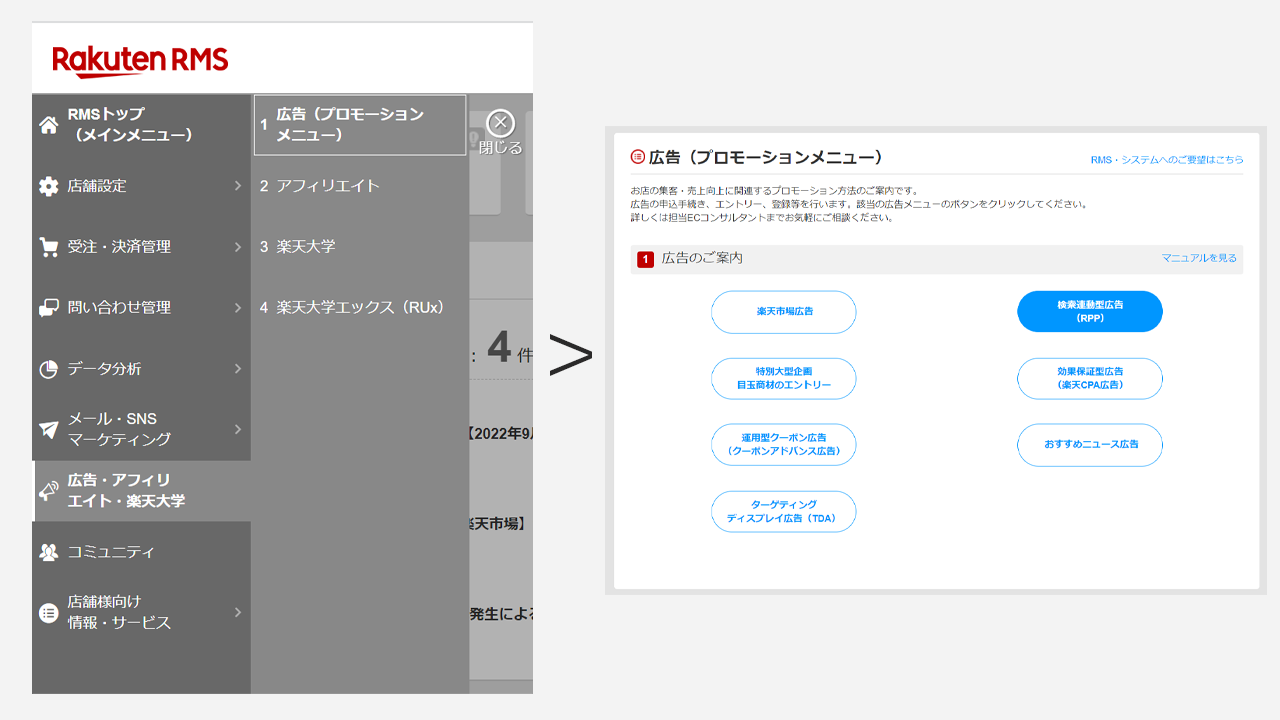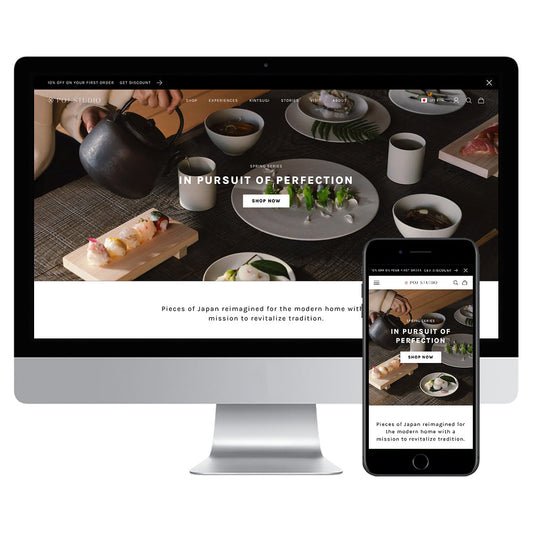If you are a Rakuten Ichiba store owner, you have probably heard of RPP at least once. However, even among those who actually use it, there are probably many who use it without really understanding how it works. In this article, we will explain the basics of RPP for beginners, how to place ads, and how to use it in different patterns.
*This article describes the specifications as of July 2022 and may be subject to change in future updates.
[Key Points of this Article]
- Understand the features and specifications of RPP
- Learn how to place RPP ads
- There is a reference for specific operation methods.
【table of contents】
What is RPP?
RPP is an abbreviation for Rakuten Promotion Platform, and is often described as search-related advertising that is displayed in conjunction with keywords searched primarily within Rakuten Ichiba.
Your ad will be displayed in the top three boxes when searching on a PC, and in the top five boxes when searching on a smartphone or app.


Although the main use of these ads is to display them during searches, they are also displayed on Rakuten Ichiba's genre pages (PC/SP) as shown in the image above, and are also posted on other Rakuten Ichiba affiliated sites, so you need to take this into consideration when measuring the effectiveness of your ads.
RPP Fees
RPP is a pay-per-click advertising system where charges are incurred only when a displayed ad is clicked, and the cost per click (CPC: Cost Per Click) incurred when a click is made can be set by the store.
The click-per-click costs that can be set are divided into product CPC, which sets the unit price for a product, and keyword CPC, which sets the unit price for the buyer's search keyword. Product CPC can be set at a minimum of 10 yen to 999 yen. Keyword CPC can be set at a minimum of 40 yen to 999 yen.
▽Product CPC
Product A ⇒ CPC 20 yen
▽Keyword CPC
Product A: Water Product A: Water Case Product A: Water 24 bottles
Monthly budgets start from 5,000 yen, but advertising costs are only charged for the actual results, so if there are fewer clicks than expected, the amount charged will be lower than the set budget.
When creating an ad with RPP, you need to set the product CPC for the entire store, and all products in the store will be advertised at the set CPC. However, there is a setting to exclude products that you do not want to appear in the ad, so it is possible for the store to control which products are advertised.
In addition, products that Rakuten Ichiba determines to be relevant to the user's search will be automatically displayed, other than those specified by keyword CPC. In this case, the product CPC or overall CPC is used as a reference.
■ Summary of RPP fees
RPP Effects and Report Summary
Performance reports for RPP can be viewed within RMS, and a calculation method called ROAS (Return On Advertising Spend) is used, which evaluates advertising based on sales in relation to advertising costs.
ROAS is calculated as "sales ÷ advertising costs × 100 (%)". For example, if you have sales of 2 million yen and advertising costs of 1 million yen, the calculation is 2 million yen ÷ 1 million yen × 100 = 200%.
By using this performance report, you can view performance data from various perspectives, such as by product or keyword, but since only up to 10 pieces of data can be displayed on the screen, you will need to download the data to see all of it.
In addition, the performance report allows you to check how long it takes for purchases to be included in advertising results (ROAS) in either 12-hour or 720-hour intervals.
If you want to take a closer look at the effectiveness of your advertising, you can refer to the 12-hour data, but since people often wait to purchase items on Rakuten Ichiba until events such as the 5th or 0th of each month or shopping marathons, it is a good idea to also refer to the 720-hour report.
*Example Product A: 1,000 yen (advertised product) → in-store visit → Product B: 2,000 yen (excluded product) → purchase Report result: Sales via advertising for Product A: 2,000 yen

Please note that the advertising results in the performance report are calculated based on cross-device statistics within the store, so even if there are sales of products other than the advertised product, they will be included in the advertising effect. Therefore, sales of products other than the advertised product will also be included in the performance report.
Features of RPP
RPP allows stores to set the cost per click, making it easy to control the effectiveness of advertising. Therefore, it is an advertising method that makes it easy for stores to get a return on their budget.
In addition, RPP tends to have a high conversion rate because it approaches people who are searching for a product. However, it is not guaranteed to be high as it also depends on the compatibility between the displayed keyword and the product. If the conversion rate is low for the keyword you want to acquire, it may be a good idea to consider it an opportunity to reconsider your products.
In addition, RPP also affects the evaluation of search rankings because sales are generated from the specified search keywords. If all goes well, it may be possible to raise search rankings through sales via advertising, and eventually reduce advertising costs while maintaining sales.
How to set up RPP
So far we have talked about the features and pricing structure of RPP, but in this chapter we will explain how to place an RPP ad.
Campaign Creation
First, create a campaign. From the left menu of RMS, select "Advertising/Affiliate/Rakuten University" and then "Advertising (Promotion Menu)."
Then select "Search-Related Advertising (RPP)" from the "Advertising (Promotion Menu)".

Once you enter the RPP menu, click on "🏁Campaign" and then click on "New Registration."

In "New Registration", first set the campaign name and status, monthly budget and product CPC (bid per click). The campaign name is optional, so give it an easy-to-understand name.
In addition, even if you create multiple campaigns, you can only deliver one campaign at a time; you cannot deliver multiple campaigns at the same time.
▽Settings Campaign name: Any name Status: Check "Enabled" if you want to distribute immediately. Check "Disabled" if you want to distribute after completing the settings for each product.
Continuing monthly budget: Enter your monthly budget. The amount you set will be applied continuously from the current month onwards.
Bid per click: Set the click bid for all products with a minimum bid of 10 yen. Product exclusion settings will be explained later.
Once you set the campaign status to "Active" and complete the registration, your ads will begin serving. Ad serving may start within a few hours or it may take 10 hours or more.
Product exclusion settings
Click the "Excluded Products" menu in the same RPP management screen to go to the operation screen. There are two ways to exclude products: "+ New Registration" where you manually register each product, and "Bulk Upload" where you upload a CSV file in bulk.
In "New Registration", you can set up to 5 products at once. Enter the product management number and click the Confirm button to move to the screen where you can confirm and register the specified products. If there are no problems, you can register them. If you want to register more than 6 products as excluded products, repeat this process.

For "Bulk Upload", first you will need to download the CSV file registration format provided, and once you have completed the CSV file, upload it and register it.

The CSV content is simple, requiring only a control column and product management number. When registering a new product, enter "n" (new) in the control column, and when deleting a product, enter "d" (delete) in the control column.

If you only have a few products you want to register, you can easily do so manually by clicking "+New Registration," but if you want to set up many products, use "Bulk Upload."
Individual settings for product CPC and keyword CPC
Finally, we will explain how to set product CPC and keyword CPC individually.
In RPP, you can set a CPC for each product separately from the product CPC you set when registering the campaign, and you can also set a CPC for keywords for each product. The minimum keyword CPC is 40 yen and up, and you can set up to 10 keywords.
The setting is done in the "Product/Keyword Settings" of RPP. There are two registration methods, "+New Registration" and "Bulk Upload", just like the exclusion settings. Basically, it is the same as the exclusion settings, but for Keyword CPC, you will register the product management number and keyword as a set, as shown in the image.
If you have a large number of products, the amount of work required to manage keyword CPCs will increase, so one solution is to narrow down the products you use. At the very least, we recommend that you manage those products with high CPCs in detail.

When manually registering keyword CPC, a "reference CPC" will be displayed. The definition of the reference CPC is listed in Rakuten Navi as follows:
"This is the approximate CPC required to appear in search results. (At the time of extracting the performance report) *This is only an estimate and does not guarantee appearance."
As stated, this is only a guideline, and in reality your ad may rank highly with half the CPC or even may not appear at all even with double the CPC.
Stores with a small budget to allocate to RPP should set the initial keyword CPC at the minimum price of 40 yen. Once registered, evaluation will be performed within RPP and the guideline CPC will become more accurate. Of course, the number of impressions will decrease, but this will prevent you from setting a high CPC to match the guideline CPC displayed before registration and spending excessive advertising costs.
Also, after you set the keyword CPC, the estimated CPC may display *1 or *2 after a while. *1 is displayed when the estimated CPC exceeds 1,000 yen and cannot be displayed.
*2 is explained as follows on Rakuten Navi:
1. Low relevance of keywords to products
2. The keyword does not display search-related ads (RPP) (there is no value to return)
3. Based on the store's most recent RPP delivery performance data, the performance does not meet certain standards and cannot be calculated (including products that have been on sale for a long time).
* If it becomes 2, it will not be delivered, so we recommend deleting the keyword and registering a different one. It may become possible to register again after a while, so if it was a major keyword, try resetting it after a while.
RPP Improvement Criteria
RPP is an advertising method that requires stores to check its effectiveness through performance reports and make improvements and adjustments.
What is important here is for the store to decide the benchmark value. The break-even ROAS line varies depending on the product, so for your own products, you should consider how much advertising costs you can spend and set the ROAS limit.
When determining the limit of ROAS, it is simple and easy to think of it as the ratio of advertising to sales.
ROAS is calculated as "sales ÷ advertising costs × 100 (%)", but when considered in terms of advertising ratio, it is calculated as "advertising costs ÷ sales × 100". If an advertising cost of 100,000 yen generates sales of 1 million yen, the former is 1,000% (ROAS) and the latter is 10% (advertising ratio).
Therefore, a store that aims for an advertising ratio of 10% of sales would aim for an ROAS of 1,000%.
Operation methods by pattern
There are various ways to operate RPP depending on the characteristics of each store's products. In this chapter, we will introduce a few ways to operate RPP.
Vertical sales store
If your store has a set main product and most of its sales are made up of main products, or if you want to have such a sales mix, we recommend that you focus on your main products.
If you want to increase your sales significantly with this type of operation, you need to take a share of the sales in the same genre on Rakuten Ichiba. Therefore, you may be competing with rival products for top rankings, which often results in a low ROAS for your main product.
However, RPP can increase sales and, as a result, improve your organic search ranking, so you should observe and determine whether an increase in access other than RPP is leading to an increase in sales, not just RPP.
Stores with many SKUs
If you have thousands of SKUs, it becomes difficult to manage keyword CPC. Therefore, we recommend that you determine the base value of ROAS and manage product CPC. The base value of ROAS is calculated from the advertising ratio to sales explained above.
Products below the set benchmark are excluded and adjustments are made so that the overall ROAS does not deteriorate. If a product with good results appears, the product CPC is increased or the keyword CPC is set.
You can reduce the amount of work by preparing an Excel spreadsheet with formulas and pasting the data downloaded from the performance report to filter out products that are below a certain threshold. If you are familiar with this, you can also directly manipulate the downloaded CSV.
Additionally, if your store sets points for different products during shopping marathons and Rakuten Super Sales, you can increase the CPC of the target products during those times and raise their display priority among the products in your store, which may increase the effectiveness of your advertising.
Stores that are just operating casually and want to improve
This is a surprisingly common case, but for stores that have been operating vaguely and want to make improvements, we recommend that you look at the product conversion rate and make adjustments. Products with high conversion rates tend to have high advertising effectiveness even if you increase the number of displays, so adjust the product CPC and keyword CPC.
Conversely, if there are products or keyword CPCs with low conversion rates, it is necessary to exclude the products or delete the keywords. Of course, depending on the product unit price and the profit margin of the product, it may be possible to make a profit even if the conversion rate or ROAS is low, so make sure you know which products you are going to change before making mechanical changes.
Points to note about RPP
First of all, RPP is an advertisement that secures product exposure, and the effectiveness of the advertisement depends on the adjustment of the CPC for the product and the store. The most important point is the competitiveness of the product and whether it is inferior to the competition.
In addition to product lineup, you can also increase your competitiveness by multiplying points and issuing coupons, so if you implement this even just during Rakuten Ichiba events, you can maximize your advertising effectiveness.
Next, the display of RPP is based on a logic that combines product score and bid price, and simply having a high bid price does not necessarily mean that a product will be displayed at the top, so in genres with a lot of competition, it is also important to nurture the product.
*Important indicators of RPP Product sales amount Number of product sales CPC unit price Product conversion rate Number of reviews Overall rating of product reviews
From Rakuten's perspective, they would want to display products that are likely to be purchased by consumers and increase sales, so it's a good idea to think about it from that perspective.
Also, although I'm repeating myself, the performance report is a cross-device tally, so it doesn't just show sales of the advertised product. Make sure to check whether the number of product sales is increasing separately from the report.
RPP Summary
Finally, we will provide a brief summary of RPP. We hope this article will be helpful for your store operations.
■ Cost: Charges are based on a pay-per-click system that is charged after a click is made.
RPP allows you to set the cost per click (CPC) for each product and keyword. Product CPC can be set as low as 10 yen, and keyword CPC can be set as low as 40 yen.
■Specifications
RPP is displayed in places other than the search results screen. When creating an ad, the ad is applied to all products, but it can be excluded. The effectiveness of the ad can be checked at any time in the performance report. Performance reports are compiled across devices.
■Points to note
RPP is merely an advertisement to increase product exposure and access
The effectiveness of RPP also depends on the products displayed and the competing products. Evaluation of advertising effectiveness is judged by setting standards for each store.





